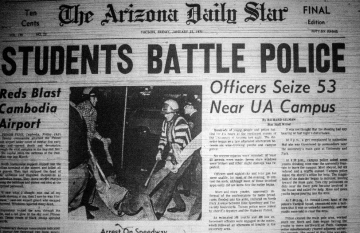How we make historical documentaries
Aengus Anderson is our oral historian and the person behind Archive Tucson, the Special Collections oral history project. Here's how he created a video that tells a story about Tucson in the 1960s.
Tucson in the Long Sixties (and how we make historical documentaries)
The Civil Rights movement. The Vietnam War. The Beatles. Haight-Ashbury. Many people know something about the sixties because they lived through it. Others think they know something about the sixties because it is endlessly caricatured in movies and television. But what do you know about the sixties in Tucson?
When Special Collections opened the fall exhibit, 1968 in America, I was asked to create a video to accompany it. In an earlier life, I studied American history as a graduate student at the University of Arizona. I was especially interested in the Southwest, so I wanted to add a bit of Tucson history to the exhibit.
This video was the result.
The challenge and the solutions
When putting this video together, my greatest challenge was simply to learn about what was happening in Tucson during the sixties. This was harder than you might think. Nobody has written a history of the sixties in Tucson, so I turned to primary sources, beginning with Special Collections’ oral history project Archive Tucson.

Archive Tucson features a diverse range of Tucsonans talking about life during the second half of the 20th century. Luckily for me, when I'm not producing videos I'm also the person who records Archive Tucson interviews, so I know my way around the collection. From those interviews I was able to find rich information about the Chicano movement, anti-Vietnam War activities on campus, and regular life in Tucson during the 1960s.
From there I dove into our rarely-touched microfilm collection, browsing the Tucson Citizen and Arizona Daily Star to broaden my sense of Tucson during the late sixties.
If you have never done this before, you will be amazed by what you find.
Photos, photos, and more photos
When I had researched enough to write a script, I found myself needing images—tons of images. Special Collections is full of photos, but finding them is challenging.
Luckily, Special Collections staff are here to help. I could have never put this video together without graduate student Kimberly Ramsey and library staff member Ashley Swinford, who scoured our photographic holdings and digitized old prints. That said, our in-house collections only covered half of the video. For everything else I had to search online resources, drawing heavily upon the amazing photos from the Arizona Daily Star.
I wish there was time to tell a more detailed story about Tucson in the sixties. Hopefully this will inspire you to explore some of our primary source material and learn more!
